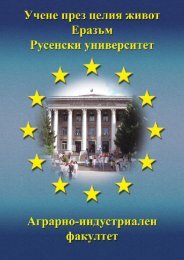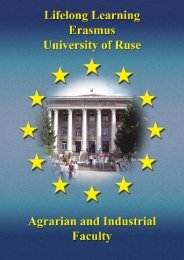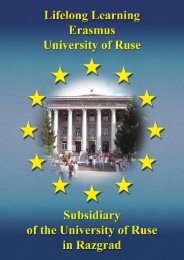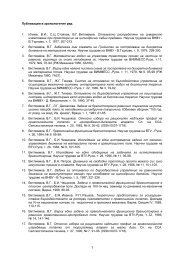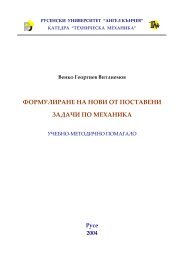Erasmus ECTS Information Package
Erasmus ECTS Information Package
Erasmus ECTS Information Package
You also want an ePaper? Increase the reach of your titles
YUMPU automatically turns print PDFs into web optimized ePapers that Google loves.
<strong>Erasmus</strong> <strong>ECTS</strong> <strong>Information</strong> <strong>Package</strong><br />
Faculty of EEEA<br />
3150 Pulse and Digital Electronics<br />
ЕСТS credits: 6<br />
Weekly classes: 2lec + 0sem + 3labs + 0ps + 1ca<br />
Assessment: exam<br />
Type of exam: written test<br />
Departments involved:<br />
Department of Telecommunications<br />
Faculty of Electrical Engineering, Electronics and Automation<br />
Lecturers:<br />
1. Assoc. Prof Nina Vasileva Bencheva, MEng, PhD, Dept. of Telecommunications, tel.: 082 888 276,<br />
Е-mail: nbencheva@ecs.uni-ruse.bg<br />
2. Principal Assistant Volodya Hristov Tsonev, Dept. of Telecommunications, tel.: 082 888 677,<br />
Е-mail: vol@uni-ruse.bg<br />
Abstract:<br />
The main objective of the course is to familiarize students with the main problems of digital electronics. It<br />
links the functions of digital elements with their microelectronic basis on one hand, and on the other hand –<br />
with their application when building pulse and digital devices. Profound knowledge in electrical engineering<br />
and semiconductors is an important course prerequisite. The subject helps to acquire knowledge in the field<br />
of hardware.<br />
Course content:<br />
Boolean algebra. Synthesis and analysis of combinational circuits. Digital circuits with memory. Forming<br />
circuits. TTL integrated circuits. CMOS logic integrated circuits. Triggers. Schmidt triggers. Multi-vibrators.<br />
Generators of linear voltage. Impulse circuits with operating amplifiers. Particularities of integrated circuits<br />
with a middle scale of integration.<br />
Teaching and assessment:<br />
Lectures give the students the opportunity to get acquainted theoretically with the main questions of digital<br />
electronics before the laboratory exercises. The students must be prepared for each laboratory exercise and<br />
at the end prepare a report for each of them. The exam is held as a written test.<br />
3151 Analog Devices<br />
<strong>ECTS</strong> credits: 6<br />
Weekly classes: 3lec+0sem+2labs+0ps+1ca<br />
Assessment: exam<br />
Type of exam: written and oral<br />
Departments involved:<br />
Department of Electronics<br />
Faculty of Electrical Engineering, Electronics and Automation<br />
Lecturers:<br />
1. Assoc. Prof. Avram Sabetay Levi, MEng, PhD, Dept. of Electronics, tel.: 082 888 375,<br />
Е-mail: alevi@ecs.uni-ruse.bg<br />
2. Assoc. Prof. Anelia Vladimirova Manukova MEng, Dept. of Electronics, tel.: 082 888 375; 082 888 682,<br />
Е-mail: amanukova@ecs.uni-ruse.bg<br />
Abstract:<br />
The subject gives the students the necessary minimum of knowledge in analog devices. It discusses the<br />
factors and methods for the realization of the most often used low-level and power amplifiers and generator<br />
stages in a discrete and integral input, methods for dc and ac analysis of the discussed circuits, as well as<br />
instructions for their design.<br />
Course content:<br />
General information about amplifying engineering; main characteristics and operation modes. Back-coupling<br />
in the amplifiers; influence of the negative back-coupling on the main values of amplifiers. Resistance of the<br />
amplifiers. Aperiodic amplifiers of small signals with a common emitter, common base and common collector<br />
by middle, low and high frequencies. Cascade circuits. Aperiodic amplifiers of power. Main elements from the<br />
analog devices of the analog integrated circuits. Differential amplifiers. Direct current amplifiers. Operational<br />
amplifiers - general characteristics and main circuits. The subject includes a course assignment .<br />
Teaching and assessment:<br />
Lectures last 2 hours and are delivered in an alternating mode: one week 2x2 lectures, another week 1x2<br />
lectures. Laboratory exercises last 2 hours and are carried out in two stages: analysis, design and<br />
measurement of the discussed device and/or computer analysis. A Course assignment is involved. The<br />
continuous assessment during the exercises is done by oral discussions, checking of homework and<br />
presentations of the course projects. Method of assessment: two hours’ written exam which accounts for 80%<br />
of the mark and a course project which accounts for 20% of the mark.<br />
127



